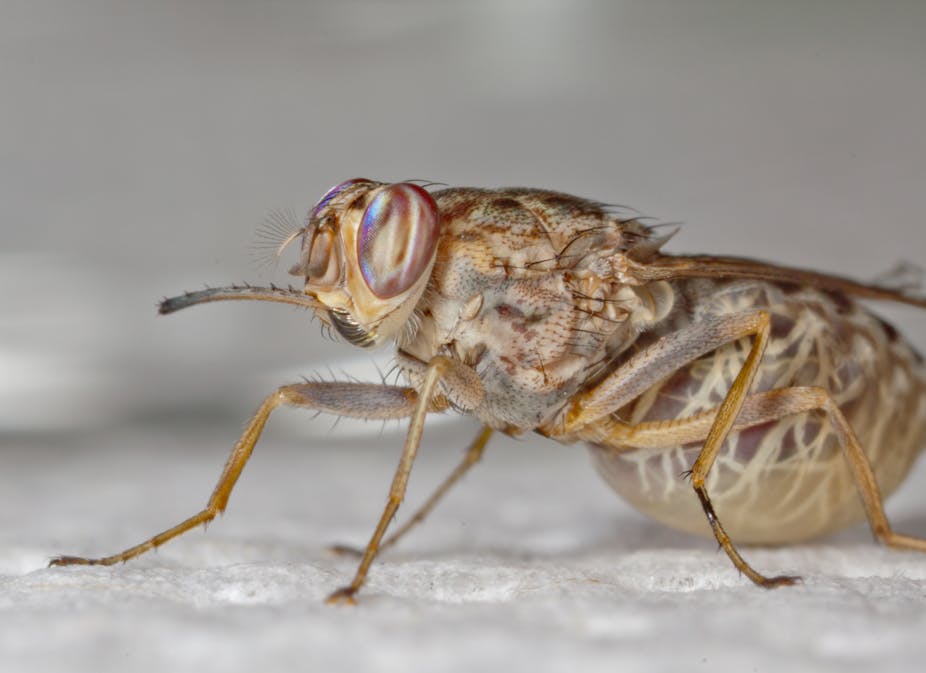After a decade of research, an international team decoded the genes of the tsetse fly – the transmitter of trypanosomiasis, or sleeping sickness. Human trypanosomiasis is a widespread tropical disease in Africa and can be fatal if not treated. Treatments are limited, but new knowledge of the tsetse fly, which carries the disease, now provides an important foundation for limiting its spread.
Thankfully, there has been a decline in sleeping sickness in recent years thanks to control measures by groups such as the World Health Organization. These have significantly reduced rates of infection – just over 7,000 cases were reported across Africa in 2012. But the job is nowhere near finished.
Firstly, the disease has yet to be eradicated. This means that when control measures are relaxed – a state of affairs that’s all too often prompted by political unrest – cases increase rapidly. Also, more needs to be done about Nagana, an even more neglected form of sleeping sickness, that affects livestock and places a huge economic burden on developing economies.
Biological foundations
Working with a collective of 146 scientists from 78 research institutes across 18 countries, we have sequenced the genome of the tsetse fly, an insect that, despite its importance, is understudied. Our hope is that developing a greater understanding of this fly’s unique biology will help us to take advantage of its vulnerabilities and one day eradicate sleeping sickness in humans and livestock across Africa.

This work is just the start, as we’ve only sequenced one subspecies of the fly – but it’s a promising one. Already we’ve identified aspects of the fly’s DNA that make it vulnerable. For instance, unlike most flies that lay eggs, tsetse flies gestate inside their mothers, feeding from specialised glands inside the uterus. If we can identify the genes that switch on milk production, we can stop flies producing young and reduce tsetse fly populations – one effective method for disease control.
Other insights into the tsetse fly genome include the discovery of DNA from a parasitic wasp virus within the tsetse genome. If the wasp itself can be found, it may be possible to use it for biological control of tsetse. Tsetse flies find their prey using by sight and smell. They have a strong colour preference for blue and black – a fact that is used in baiting tsetse traps.
We found evidence for this colour preference in the genome – tsetse flies have a limited range of light receptors but we found one similar to the blue colour receptor of fruit flies. We also found far fewer receptors of smell and taste than seen in mosquitoes or fruit flies. It may be possible to use this knowledge to improve tsetse traps by really working out their favourite tastes and odours.
Economic impact
The next stage of research needs to tackle Nagana. This disease devastates livestock and, in turn, the economies of small rural communities in parts of Africa where it is endemic. It’s thought that eradicating this disease could save rural African economies billions of dollars.
Cattle affected by Nagana, like humans with sleeping sickness, become very weak. In cattle the disease is often fatal but where animals do survive, growth, milk yields and fertility are impaired. Across central African regions farmers use breeds of cattle that are less susceptible to Nagana, but these hardy animals produce very little meat compared with varieties used in more developed countries. Wiping out Nagana will enable farmers to keep efficient, productive livestock that will feed growing communities and create wealth.
Next steps
Further research will also need to look in more detail at natural genetic variation among tsetse flies. Using this genome as a basis, we’ll want to sequence other flies that have been caught in the wild to find out how they are adapting to insecticides and other control measures. This will also help us to improve our control strategies and target different tsetse sub-species in different regions more effectively.
As is often the case, a genome sequence is a starting point. The genome can help to make vital decisions about targets for control mechanisms and treatments. However, the changes needed to make a real impact on communities require political will to coordinate activities across national boundaries and substantial investment in further research, monitoring and control measures.

